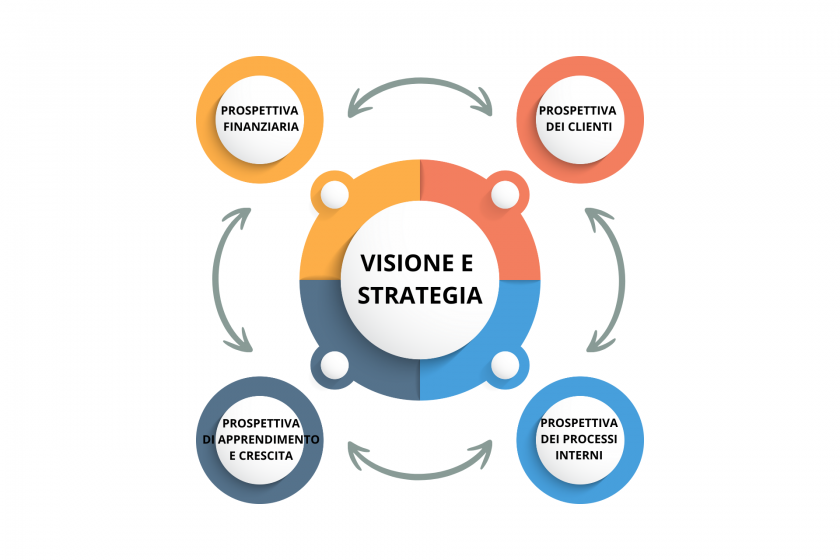In the project management domain, the Balanced Scorecard (BSC) has made a name for itself as an essential tool for project managers.
This method provides a comprehensive view of business performance by linking strategic goals with operational activities.
INDICE
Let’s see what it is about and how to implement it effectively.
Balanced Scorecard origins
The Balanced Scorecard (BSC) concept was introduced in 1992 by Robert S. Kaplan and David P. Norton.
These two pioneering thinkers changed the business strategic management and performance monitoring scenario. Their groundbreaking approach stemmed from the realization that traditional methods of assessing corporate performance, based primarily on financial indicators, were inadequate for comprehensive and effective strategic management.
Kaplan and Norton presented the BSC as a framework that balances financial indicators with other measures related to critical success factors.
The idea was to provide managers with a more balanced and comprehensive tool to monitor and guide business performance. The Balanced Scorecard not only considers financial performance but also integrates metrics related to customer satisfaction, the efficiency of internal processes, and the company’s capability for innovation and growth.
Since then, countless businesses have adopted and adapted the BSC worldwide, growing into one of the most influential and widespread strategic management tools.
Over the years, Kaplan and Norton have further developed and refined the BSC concept. They introduced the idea of “strategy maps,” which help organizations visualize cause-and-effect relationships between different strategic objectives. This has further established the BSC as a tool for performance measurement and strategic planning and execution.
Today’s application is more than just performance measurement, influencing corporate culture, internal communication, and strategic decision-making.
Tools like Twproject can play a crucial role in BSC implementation and monitoring, providing an integrated platform for aligning strategic goals with day-to-day activities.
The four perspectives of the balanced scorecard
The Balanced Scorecard differs in its holistic approach to business performance measurement, structured around four key perspectives.
These perspectives help organizations balance short-term goals with long-term targets by considering various aspects critical to success.
Here is a detailed analysis of each perspective:
- Financial perspective: This perspective focuses on a business’s economic aspects and financial health. Key indicators in this category include return on investment (ROI), cash flow, revenue growth, and profitability. The goal is to ensure that business decisions and project initiatives contribute positively to financial performance. As such, the BSC helps managers understand how operational strategies affect financial performance.
- Customer satisfaction: This element estimates the degree of customer satisfaction and loyalty by considering the company from the customer’s point of view. Indicators such as customer satisfaction, market share, number of customer complaints, and Net Promoter Score (NPS) are commonly used. The goal is to improve service quality, customer relationships, and, ultimately, customer loyalty. This perspective stresses the importance of listening and responding to customer needs for long-term success.
- Perspective of internal processes: this perspective focuses on the efficiency and effectiveness of an organization’s internal processes. It focuses on considering how internal processes can be optimized to improve overall performance. Indicators such as cycle time, product/service quality, and operational efficiency are essential. The goal is to identify and improve critical processes directly affecting customer satisfaction and financial performance.
- Learning and growth: also known as the innovation and growth perspective, this aspect focuses on developing human resources, information systems, and the organization in general. Indicators such as employee satisfaction and training, rate of innovation, and effectiveness of information systems are central. The purpose is to create an environment that fosters continuous learning and innovation, thus ensuring the long-term sustainability and growth of the organization.
By integrating these four perspectives into a consistent framework, the Balanced Scorecard empowers managers to gain a comprehensive and balanced view of business performance.
This approach ensures that strategic decisions are made by factoring in various critical factors rather than relying solely on short-term financial measures.

Successful implementation of the Balanced Scorecard
Implementing the Balanced Scorecard (BSC) in an organization is a process that requires commitment and strategic planning.
Here is a step-by-step guide to a successful implementation:
- Strategic goal setting: The first step in BSC implementation is to set the organization’s strategic goals. These goals should reflect the corporate mission and vision and be clear, measurable, and achievable. These goals must be aligned with the four perspectives of the BSC to ensure a balanced approach.
- Performance Indicators selection (KPIs): Having defined the goals, the next step is choosing key performance indicators (KPIs) for each BSC perspective. These KPIs should be directly related to the strategic goals and provide a clear measure of progress toward achieving those goals. It is crucial to select relevant, reliable, and easily measurable KPIs.
- Engagement and communication with your team: BSC implementation can only be successful with your team’s full support and involvement. Communicating the goals, KPIs, and values of the BSC clearly to all levels of the organization is key. Training and education of staff on how to use the BSC in their daily routines are critical to ensure the adoption and effectiveness of the system.
- Business processes integration: the BSC should be integrated into existing business processes. This means linking BSC objectives to operational plans, budgets, and reporting systems. This alignment ensures that the BSC is not perceived as an isolated initiative, but as an integral part of business management.
- Regular monitoring and review: Once implemented, the BSC requires regular monitoring and review – This includes periodic analysis of KPIs, assessing progress toward strategic goals, and adjusting strategies as necessary. It is crucial to set up a regular review process to ensure that the BSC remains relevant and aligned with the organization’s evolving needs.
- Use of project management tools: Tools such as Twproject can be pivotal in BSC implementation. As a matter of fact, it offers features that help to easily track progress toward goals, monitor KPIs, and generate detailed reports. Using such tools can significantly simplify the monitoring and review process, making BSC implementation more manageable and less burdensome.
Balanced Scorecard: a strategic change in business
Adopting the Balanced Scorecard represents more than simply implementing a new management tool; it is a strategic move that can potentially transform the whole corporate culture.
This transition begins by reconsidering how the organization measures and interprets success, shifting the focus from short-term financial measures to a more holistic, long-term view.
It is an approach that helps pinpoint and close gaps between business strategy and day-to-day operations, ensuring that every part of the organization is aligned with long-term goals.
The introduction of BSC often increases employees’ awareness of the company’s strategic goals. This can increase engagement and motivation as employees better understand how their work contributes to the organization’s overall success.
It also fosters greater collaboration among different departments and encourages a shared vision of the company’s goals.
Another important aspect of BSC-induced strategic change is promoting innovation and continuous learning.
With its emphasis on the learning and growth perspective, the BSC encourages companies to invest in developing their employees’ skills and seeking new opportunities for innovation. This not only improves employees’ skills and productivity but also contributes to the company’s long-term sustainability.
However, this strategic shift comes with its challenges. It requires effective communication from leadership and a commitment to support staff during the transition.
Companies must be prepared to face internal resistance and manage expectations during the BSC implementation process.
The key to overcoming these challenges is to maintain open communication, provide appropriate training, and demonstrate how the BSC can bring tangible benefits through concrete actions.
Why use TWproject for Balanced Scorecard implementation?
Twproject is project management software that can help you implement the Balanced Scorecard in your business. It can be used for:
- Defining your vision and strategy: It can help you frame and document your company’s vision, mission, and strategy. This information can then be used to create a Balanced Scorecard aligned with your overall goals.
- Finding critical success factors: You can use Twproject to pinpoint the most important factors for your company’s success. This information can then be used to set goals and measures for each critical success factor.
- Tracking progress: This software can be used to track progress toward your Balanced Scorecard goals and metrics. This information can then be used to make data-driven decisions about your business strategy.
- Communicating results: Twproject can help share the results of your Balanced Scorecard with your company’s stakeholders. This information can help align everyone to a shared vision and strategy.
Bottom line is that implementing the Balanced Scorecard requires strategic planning, organizational commitment, and the use of the right tools.
By following these steps, companies can ensure that they adopt the BSC effectively, making it a powerful tool for achieving strategic goals and continuous improvement in business performance.



